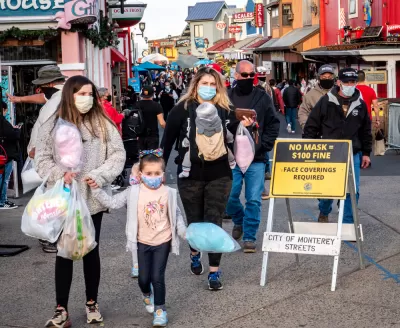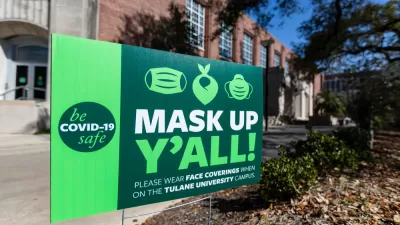All Americans, vaccinated and unvaccinated, are still in this pandemic together.

[The headline for this article was updated on August 17, 2021.]
Centers for Disease Control and Preventions (CDC) Director Rochelle Walensky introduced the questionable term "pandemic of the unvaccinated" during the White House COVID-19 Response Team's press briefing on July 16 after giving an update on the soaring infection numbers and increases in daily average hospital admissions and deaths from COVID-19.
"There is a clear message that is coming through: This is becoming a pandemic of the unvaccinated," said Walensky. "We are seeing outbreaks of cases in parts of the country that have low vaccination coverage because unvaccinated people are at risk. And communities that are fully vaccinated are generally faring well."
Due to the high transmissibility of the Delta variant and the elimination of most coronavirus restrictions and mask mandates by states and local governments in the U.S. after infections dropped steeply following the fall 2020/winter 2021 surge, the pandemic has changed, with nearly 94% of all counties experiencing high or substantial community spread, according to the CDC's "COVID-19 Integrated County View" for the week of "Sun Aug 08 2021 - Sat Aug 14 2021."
Nationwide concern
Reporters at The Washington Post took notice of the surge in cases nationwide with an eye on vaccination levels in the 50 states. "The analysis illustrates how rapidly the state of the pandemic changed in July from a problem for the unvaccinated to a nationwide concern, though life in highly vaccinated states is still safer," write Naema Ahmed, Aaron Steckelberg, Fenit Nirappil, Dan Keating and Maria Aguilar on Aug. 12.
The key finding of the Post's analysis: "Two-thirds of people who live in the nation’s most highly-vaccinated counties reside in a place now considered a hot spot."
Two months earlier...
Just two months earlier, three of the five Post reporters had concluded the opposite: "Coronavirus infections dropping where people are vaccinated, rising where they are not, Post analysis finds."
"Nationally, 43 percent of eligible Americans are fully vaccinated, and the country is averaging under 16,000 new infections a day — levels not seen since the early days of stay-at-home orders in March 2020," wrote Keating, Ahmed, Nirappil, Isaac Stanley-Becker and Lenny Bernstein on June 14. Daily new cases reached their nadir a few weeks later on July 5 with a 7-day average of 10,608, according to The New York Times coronavirus tracker, and within days would begin to increase exponentially.
On Aug. 15, daily new cases are averaging over 130,000, but the rate of increase has slowed, up 64% from two weeks ago, according to the Times tracker. The rates of increase for hospitalizations and deaths are now higher, 65% and 113% respectively, from two weeks ago, with over 76,000 Americans hospitalized with COVID and over 660 on average dying daily.
Hot spots and vaccination levels
Over 168 million Americans, or 50.7% of the total population, was fully vaccinated on Aug. 15, according to the CDC's tracker. The reporters divided America's counties into low, medium and high vaccination levels and tracked the increase in hot spots, i.e., transmission rates in substantial (orange) and high (red) levels on CDC's county-view map.
Even in communities where at least 70 percent of the population is fully vaccinated, delta is so widespread that 6 in 10 residents are in hot spots.
While there was a direct correlation between low vaccination states and high hospitalization rates, clear evidence that COVID-19 vaccines are highly effective against severe disease, the same relationship did not exist with infections.
Public health leaders in highly vaccinated hot spots attributed the outbreaks to several reasons.
Even urban areas that can boast high vaccination rates have hundreds of thousands or millions of susceptible unvaccinated residents who are at greater risk of contracting the virus than during earlier spikes because businesses have reopened. Masks are often not required in public, and the delta variant spreads more easily.
Breakthrough infections do not appear to be as extremely rare as hoped, accounting for more than a fifth of new recent infections in Los Angeles; New Haven, Conn.; and Oregon, officials said.
Provincetown
While New Orleans doesn’t have reliable data on the prevalence of breakthrough infections, Jennifer Avegno, director of the New Orleans Health Department, "suspects they may be common," add Ahmed, Steckelberg, Nirappil, Keating and Aguilar.
She cited the recent CDC study of an outbreak in Provincetown, Mass., where three-quarters of the infected were fully vaccinated, bolstering suspicions that vaccinated people are more easily spreading the transmissible delta variant even in vaccinated communities. More than 1,000 people were infected; seven were hospitalized.
[See related post, "COVID-19, AIDS, and CDC Guidance," scroll down to the section headed, "Provincetown – the game-changer."]
Breakthrough hospitalizations
During the same White House press briefing on July 16 where CDC Director Walensky coined the term, "pandemic of the unvaccinated," she also claimed that "97 percent of people who are entering the hospital right now are unvaccinated." On Aug. 10, the Los Angeles Department of Public Health released data for July indicating that percentage has decreased:
There are 1,503 people with COVID-19 currently hospitalized and 23% of these people are in the ICU. In late July, about 94 people newly admitted to a hospital each day were positive for COVID-19; of these 88%, were unvaccinated.
Fifty-five percent of the population in Los Angeles County is fully vaccinated, placing it in the reporters' "high vaccination" classification for their analysis.
Making a point noted in an April post tagged "Reopening California," Public Health Director Barbara Ferrer told The Washington Post that "she was wary of California’s June 15 full reopening from the start."
Even though vaccinated people as individuals are protected, the communities they live in are not out of the woods when no major jurisdiction has reached the 80 to 90 percent immunity some experts now believe is necessary to protect against delta outbreaks.
Mask mandates for unvaccinated and vaccinated
Ferrer issued an indoor masking recommendation on June 28. On July 15, it became a mandate.
"Los Angeles County health officials credit the universal masking order for helping to control the latest surge, citing slower case growth than in parts of California without mask mandates," add Ahmed, Steckelberg, Nirappil, Keating and Aguilar.
Another high-vaccination county to impose a mask mandate is New Haven, Connecticut, with 63% of the county's population fully vaccinated, according to The New York Times tracker.
Of the 624 New Haven cases reviewed since July, 22 percent were fully vaccinated. Health Director Maritza Bond said preliminary data suggests the breakthrough cases are disproportionately among seniors and people with preexisting medical conditions that would make it harder for their immune systems to fight the virus, even after vaccination.
The city issued the indoor mask mandate on Aug. 6, 10 days after the CDC revised their "Public Health Recommendations for Fully Vaccinated People" to recommend indoor masking in public places in areas of substantial or high transmission. With an average of 16 cases per 100,000 people on Aug. 15, the county is one of the 84% of the nation's counties that meets the high transmission threshold.
Revising the masking guidance on July 27, largely a result of the Provincetown breakthrough data, likely influenced some cities and counties to recommend or mandate indoor masking. The CDC should go further and drop the use of the polarizing term, "pandemic of the unvaccinated" to ensure the full participation of all Americans int he public health measures necessary to control and finally defeat the spread of the coronavirus that causes Covid-19.
All Americans, vaccinated and unvaccinated, are in this pandemic together.
Related in Planetizen:
FULL STORY: Spread of delta variant ignites covid hot spots in highly vaccinated parts of the U.S., Post analysis finds

Alabama: Trump Terminates Settlements for Black Communities Harmed By Raw Sewage
Trump deemed the landmark civil rights agreement “illegal DEI and environmental justice policy.”

Study: Maui’s Plan to Convert Vacation Rentals to Long-Term Housing Could Cause Nearly $1 Billion Economic Loss
The plan would reduce visitor accommodation by 25% resulting in 1,900 jobs lost.

Planetizen Federal Action Tracker
A weekly monitor of how Trump’s orders and actions are impacting planners and planning in America.

Baltimore Ordered to Improve Sidewalk Accessibility
The city is one of many to face lawsuits for failing to comply with the Americans with Disabilities Act.

This Toronto Suburb Has More Bus Riders Than Columbus, Ohio
Brampton, Ontario used gradual improvements in service to prove that if you build it, they will ride.

Paris Bike Boom Leads to Steep Drop in Air Pollution
The French city’s air quality has improved dramatically in the past 20 years, coinciding with a growth in cycling.
Urban Design for Planners 1: Software Tools
This six-course series explores essential urban design concepts using open source software and equips planners with the tools they need to participate fully in the urban design process.
Planning for Universal Design
Learn the tools for implementing Universal Design in planning regulations.
Smith Gee Studio
Alamo Area Metropolitan Planning Organization
City of Santa Clarita
Institute for Housing and Urban Development Studies (IHS)
City of Grandview
Harvard GSD Executive Education
Toledo-Lucas County Plan Commissions
Salt Lake City
NYU Wagner Graduate School of Public Service





























